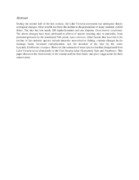| dc.contributor.author | Aloo, P.A. | |
| dc.date.accessioned | 2022-12-05T13:20:47Z | |
| dc.date.available | 2022-12-05T13:20:47Z | |
| dc.date.issued | 2003-05 | |
| dc.identifier.citation | Biodiversity & Conservation volume 12, pages905–920 (2003) | en_US |
| dc.identifier.uri | https://doi.org/10.1023/A:1022869624524 | |
| dc.identifier.uri | https://karuspace.karu.ac.ke/handle/20.500.12092/2671 | |
| dc.description | Biological diversity of the Yala Swamp lakes | en_US |
| dc.description.abstract | During the second half of the last century, the Lake Victoria ecosystem has undergone drastic
ecological changes. Most notable has been the decline in the populations of many endemic cichlid
fishes. The lake has lost nearly 200 haplochromines and one tilapiine, Oreochromis esculentus.
The above changes have been attributed to effects of species stocking and, in particular, from
predation pressure by the introduced Nile perch, Lates niloticus. Other factors that have led to the
decline of the endemic species include intensive non-selective fishing, extreme changes in the
drainage basin, increased eutrophication, and the invasion of the lake by the water
hyacinth, Eichhornia crassipes. However, the remnants of some species that had disappeared from
Lake Victoria occur abundantly in the Yala Swamp lakes (Kanyaboli, Sare and Namboyo). This
paper discusses the biodiversity of the swamp and the three lakes and gives suggestions for their
conservation | en_US |
| dc.language.iso | en | en_US |
| dc.subject | Biological diversity | en_US |
| dc.subject | Lake Victoria | en_US |
| dc.subject | Threats and conservation | en_US |
| dc.subject | Yala Swamp lakes | en_US |
| dc.title | Biological diversity of the Yala Swamp lakes, with special emphasis on fish species composition, in relation to changes in the Lake Victoria Basin (Kenya): threats and conservation measures | en_US |
| dc.type | Article | en_US |
